As China steps up its efforts in wildlife protection, it is starting to witness real revivals of the populations of some iconic species. But amid the country’s breakneck economic development, what status does wildlife protection itself have?
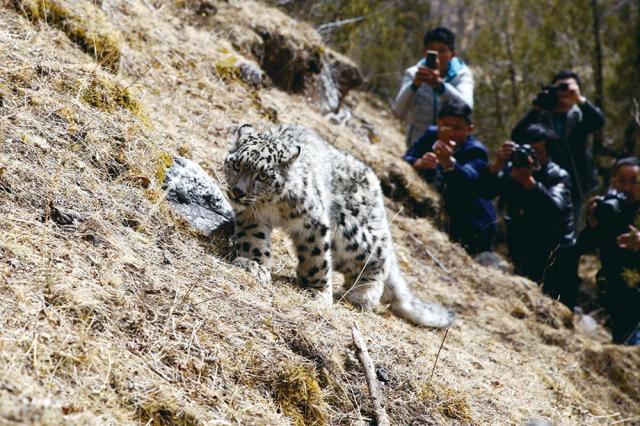
Snow leopards are a common sight in parts of the Qinghai-Tibetan Plateau, due to local Tibetans’ protection efforts / Photo by Wang Dongmei
On July 19, local villagers in Machuanzi, some 10 kilometers away from Hunchun city centre, spotted an Amur tiger that had entered their residential area, then killed and eaten two dogs. Despite living inside the buffer zone area of the Hunchun National Nature Reserve in China’s northeastern Jilin Province, near the border with Russia, most villagers in Machuanzi will never encounter a living tiger due to the scarcity of the species.
Yet in recent years, thanks to better conservation efforts, China’s northeastern forested areas have seen a gradual revival of the tiger population. News of tigers attacking cattle raised by local herders in the region are becoming frequent. In Hunchun alone, the number of tiger attacks on cattle has passed 100 a year.
Revival
The Amur tiger, also known as the Siberian tiger, is a key species of the forest ecosystem and once lived across the far east of Russia and northeastern China. Its numbers and geographic range declined dramatically over the past century due to habitat loss and fragmentation, poaching and a scarcity of prey. Excessive land exploitation and logging across a large area of virgin forest for the sake of development, particularly on the China side, led to a collapse of Amur tiger numbers in China to just 150 - 200 by the 1970s and to a mere 16 - 18 surviving animals by the late 1990s.
Thanks to protection efforts from China’s central government – the National Forest Protection Program (NFPP) and National-Level Nature Reserves (NNRs) – the dire situation started to change. The NFPP was implemented to restrict logging in 1998 in response to flooding caused by deforestation. Jilin implemented a complete ban on commercial logging in the province in 2015. Statistics released by Jilin Forestry Department indicate forest coverage regained its coverage amounting to 43.9 percent of the province.
Beginning in 2001, three national nature reserves - Hunchun, Wangqing and Huangnihe - were set up in Jilin province, near China’s borders with Russia and North Korea, for the protection of Amur tigers listed as endangered on the IUCN Red List of Threatened Species, and Amur leopards, listed as critically endangered.
To protect the integrity of the habitat, Jilin’s provincial government even canceled a highway project, and rerouted a high-speed railway connecting Hunchun to Russia’s coastal city of Vladivostok. The Tiger and Leopard National Park Pilot Project, the plans for which were presented by Jilin Province to the central government for approval this May, hopes to draw more national support both financially and technically for the protection of the tigers. According to an insider who spoke to NewsChina, the national park would cover a total area of 14,600 km2, to connect the existing Hunchun Nature Reserve with the nearby Wangqing Nature Reserve in Jilin and Laoyeling Nature Reserve in neighboring Heilongjiang Province.
“The number of Amur tigers in China has seen a modest recovery to over 30 in total now after more than a decade of conservation efforts, and in Jilin Province alone, twenty-seven of them have been tracked,” ecologist Xie Yan from the Institute of Zoology at the Chinese Academy of Sciences and founder of a conservation NGO called Global Protected Area Friendly System (GPAFS) explained to our reporter.
According to Jilin Forestry Department’s monitoring results, four young female tiger cubs will mature into adults of breeding age in the coming years, leading Chinese experts in tiger conservation programs to predict increasing numbers of the species in the near future. According to Jilin Province Forestry Department, a total of 42 Amur leopards, a species declared as extinct in China by IUCN in 2007, have been spotted within the province.
Iconic Species
Amur tigers are not the only species to see the benefits of the country’s efforts to improve protection. Other high-profile species, including the giant panda, Tibetan antelope and black snub-nosed monkey, have also seen their populations recover. Over the past two decades, thanks to effective, concerted efforts including habitat restoration and the combating of illegal poaching, the Chinese government has restored the numbers of these species to a healthy and sustainable level.
A stand-out story is that of the giant panda. The total number of giant pandas living in the wild has risen from 1,100 in the late 1980s to over 1,800 by late 2013. This has resulted in the giant panda being downgraded from ‘endangered’ to ‘vulnerable’ on the IUCN Red List in September. The Tibetan antelope, also known as the Chiru, once under severe threat from hunting in the late 1980s and 1990s, has also been reclassified, dropping two levels from ‘endangered’ to ‘near threatened.’
“This reclassification recognizes decades of successful conservation efforts led by the Chinese government and demonstrates that investment in the conservation of iconic species like giant pandas does pay off - and benefits our society as well as species,” wrote Lo Sze Ping, CEO of WWF-China on the foundation’s website.
During a recent interview with NewsChina, Li Ming, a researcher at the Institute of Zoology of the Chinese Academy of Sciences, also revealed that the number of black snub-nosed monkeys in southwestern China, a species listed as ‘endangered’ on the IUCN Red List, has recovered from 1,700 in the early 2000s to over 3,000 at present.
In recent years, the country’s top leaders have begun to reflect on the impact of decades of development under a model where growth came at the expense of the natural environment. Now that these leaders have started to emphasize the importance of ecology, local authorities are responding to the new emphasis from the center.
Construction projects began to be called off for the sake of conserving biodiversity. NewsChina has learned from various sources that Qinghai Province canceled a giant hydro-power station project planned on the upper reaches of the Yangtze River in 2014 due to scientific evidence proving the area’s rich biodiversity, including the presence of over ten snow leopards.
Lian Xinming of the Northwest Plateau Institute of Biology at the Chinese Academy of Science, who participated in the biodiversity research in Yanzhanggua Gorge where the hydro-power station was supposed to be built, told NewsChina that the combination of NGO involvement, scientific efforts and the participation of local communities, had finally pushed the government to revert to its previous development plans.
Yang Xin, founder of the conservation NGO Green River, disclosed to NewsChina that soon after the canceling of the hydropower project in 2014, Qinghai’s government even released an internal document to call off all smaller hydropower projects across the province. “It is even more gratifying that our NGO has established sound cooperation with various levels of government within Qinghai, and we are now joining hands with the government in a few preservation initiatives,” Yang Xin added.
Halting a hydropower project purely for the sake of wildlife preservation is unprecedented in China.
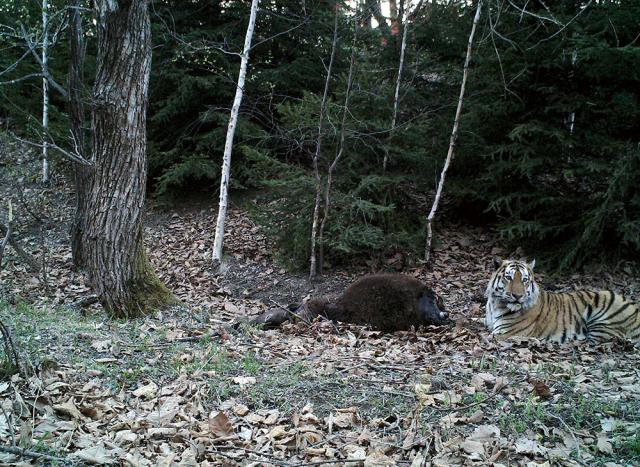
An Amur tiger and its prey, a local farmer’s cow, photographed by a camera trap near Hunchun National Nature Reserve / Photo courtesy of Hunchun Forestry Bureau

A wild giant panda photographed by a tourist near a town in Ya’an, Sichuan Province, March 20, 2012 / Photo by IC
Parallel Reality Yet contrary to the rosy picture of preservation of a handful of iconic species, the reality remains far harsher for most species in the wild. In July this year, 19 Himalayan musk deer, a species listed as ‘endangered’ by the IUCN, were found dead in western Sichuan Province. Four suspected poachers were later caught by local police for setting snares to catch the deer.
The musk deer lives in mountainous areas at altitudes between 2,500 and 5,000 meters and is prized for its musk secretion, which has very high medicinal - and economic - value in traditional Chinese medicine. A male musk deer can produce about 20 grams of musk a year and the price for this wild musk is 800 - 1,000 yuan (US$120 - $150) per gram.
According to Professor Meng Xiuxiang from Renmin University, an expert on musk deer, the population of the deer has continuously fallen since the 1960s, despite the animal’s protection level being upgraded from second class to first class in 2002 to stop hunting of the species. “China is home to the majority of the world musk deer population,” explained Meng to NewsChina: “Overall, the population of musk deer in China shrank by 90 percent from the 1960s to the 1990s, and shrank by another 90 percent from the 1990s to today.”
According to Lü Zhi, professor of Conservation Biology at Peking University, conservation results are not in reality particularly successful. She said in late September when giving a speech that the total existing national nature reserves cover just five percent of the total forested areas in China. Lü, an expert in giant panda conservation, disclosed that, according to research, the region of natural habitat in Sichuan most suitable for giant pandas has shrunk by 10 percent over the last decade.
In a paper published in Biodiversity Science in 2015 entitled “Gap Analysis on National Nature Reserves in China Based on the Distribution of Endangered Species,” research results indicated that there is a significant gap between the coverage of National Nature Reserves and the distribution and hotspots of most endangered species in China, namely all plant and animal species under Level 1 special state protection, and avian species classified as ‘critically endangered’ and ‘endangered’ on the IUCN Red List.
“Furthermore, many endangered species are not yet included on the State protection list,” said Lü Zhi during her speech, “which has made things even worse.”
China’s List of Wild Animals Under National Protection was drafted in 1989 and has not been updated during the past three decades. Therefore, many endangered species have not received sufficient protection. For example, the Yangtze finless porpoise, the world’s only freshwater porpoise, was upgraded from ‘endangered’ to ‘critically endangered’ on the IUCN Red List in July 2013. Despite there being possibly fewer than 1,000 living in the wild, the species remains on China’s endangered wildlife list as receiving only Level 2 special state protection.
“How to strengthen the protection of non-iconic species remains a critical issue for the country to consider,” said Wang Ding, researcher at the Institute of Hydrobiology at the Chinese Academy of Sciences, to NewsChina in late September.

Police intercept the smuggling of 61 live pangolins in Guangdong Province, September 27, 2016 / Photo by Luo Shanxin
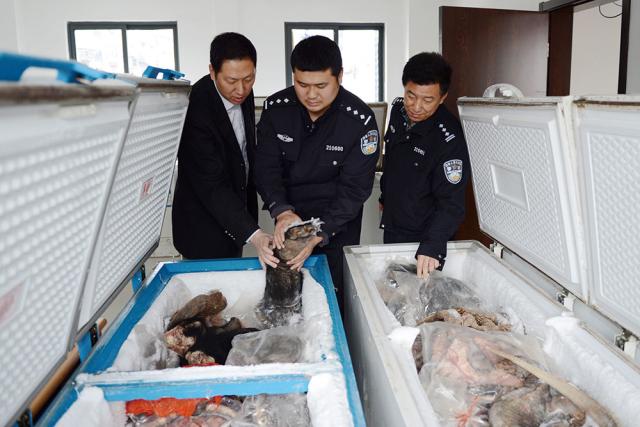
Court judge inspects confiscated wildlife parts including tiger skin, bear pans, and pangolins in an illegal wildlife trade case in Jiangsu Province on April 23, 2014 / Photo by CNS
Farming Wildlife According to China’s current Wildlife Protection Law (WPL), which came into effect in 1989, it is legal or even encouraged for stakeholders to ‘utilize’ animal resources through the captive breeding or farming of wildlife. The legalization of the trade in wildlife body parts and products for either medicinal or food purposes has posed a threat to many of the same species in the wild in China.
For many years, tigers have fallen victim to these legal loopholes. Under the guise of captive breeding, tiger farms produce and sell tiger bone wine, stimulating consumer demand that fuels the illegal hunting of wild tigers or using their centers as a front for trading in poached tiger products. The legal loophole, if not closed, remains a perfect cover for the illegal trade in endangered species, creating law enforcement challenges, and stimulating the trade of illegal wildlife. Evidence has shown that with tigers, bears and pangolins depleted in the wild in China, the huge demand for tiger bone, bear bile and pangolin scales now threatens the survival of these species in other Asian countries and even further afield.
According to Zhang Li, professor of Zoology at Beijing Normal University, it is estimated that the general annual demand for pangolin as food and medicine in China remains at over 200,000 animals per year, despite the species being listed as critically endangered on the IUCN Red List. Statistics from the Convention on International Trade in Endangered Species of Wild Fauna and Flora (CITES) indicate that in somewhat over twenty years, the number of Chinese pangolin has fallen by over 90 percent. Since the early 1990s, due to the depletion of domestic pangolin numbers, China started importing pangolins from Southeastern Asian countries including Myanmar and Vietnam. A recent report conducted by the China Biodiversity Conservation and Green Development Foundation revealed that there are over 10 registered private pangolin farms in China, in addition to which, over the past two decades, China imported almost 15 tons of pangolin scales, derived from the poaching of 14,890 pangolins.
This September, CITES unanimously agreed to transfer all eight pangolin species from Appendix II to Appendix I. Species on Appendix I are the most endangered, threatened with extinction and CITES prohibits international trade of these species save when the purpose of the import is not commercial but for another reason such as scientific research.
Xi Zhinong, one of China’s pioneering wildlife photographers, expressed to NewsChina in August his worry regarding the general situation of China’s wildlife conservation. Xi opposed the legalization of captive breeding and commercial utilization of certain wildlife species including pangolin, giant salamanders (‘critically endangered’ on the IUCN red list) and bears. “It’s legal to raise giant salamanders and bears, and then animals caught in the wild are brought into rescue centers and passed off as bred in captivity. If we don’t make changes from the roots up and only save the iconic species, the law will still be a ‘Wildlife Protection and Exploitation Law.’ The downfall of our system is that we can only rely on people’s goodness,” said Xi.
Apart from the cruel reality of wildlife utilization for medicinal or food purposes, those wild animals alive in captivity either in farms or private zoos are also facing severe maltreatment.
Across the country, there are over 400 wildlife parks, most of which are owned by private enterprises. Driven by profit, most of them are poorly managed in terms of the animal’s welfare, posing potential security problems or causing captive animals to suffer from various health conditions.
In late July, tragedy struck in the privately-operated Badaling Wildlife World on the northern outskirts of Beijing, when two women who left their car in the tiger enclosure were attacked by an Amur tiger. Ecologist Xie Yan later pointed out in an interview with NewsChina that the tragedy was linked to the way the tigers were fed inside the park. “To increase income, the wildlife park sold live animals such as chickens to visitors and allowed them to feed tigers or other carnivores directly,” explained Xie. “This behavior led those tigers to link food directly with humans’ presence. Captive tigers thus are not aware, as their counterparts in the wild know, there is risk in attacking a human.”
According to Freedom for the Animal Actors, a Beijing-based animal welfare NGO, Badaling Wildlife World is notorious for its maltreatment of its captive wild animals. “The animal welfare situation there is very bad, and we have kept calling the authorities to try to get them to shut it down,” Hu Chunmei, their project manager, told NewsChina in late July. As Hu explained, despite a 2010 policy recommendation that banned performances by animals in zoos, a number of wild animals remain caged for the purposes of public display and performances. Furthermore, quite a number of animals, including elephants, zebras and takin, are suffering from serious diseases, but have not yet received proper treatment.
“We highly recommend that the country limit the number of wildlife parks, and to
improve the animal welfare situation to better protect our wildlife,” said Xie Yan.
Human activity has pushed extinction rates of animals and plants far above the long-term average, part of the “Anthropocene Age,” the “age of humanity.” The Earth is on course to see 75 percent of species become extinct in the next few centuries if current trends continue.
In the case of China, positive changes are possible in terms of a wise revision of the current Wildlife Protection Law and update of the List of Wild Animals Under National Protection. This July a newly revised Wildlife Protection Law, the first in its 27-year history, was passed and will take effect next year. This is regarded by the general public as a critical turning point for the future preservation of species in China. For now no one can be sure whether the amendments to the law are wise enough to effectively protect wildlife in general.
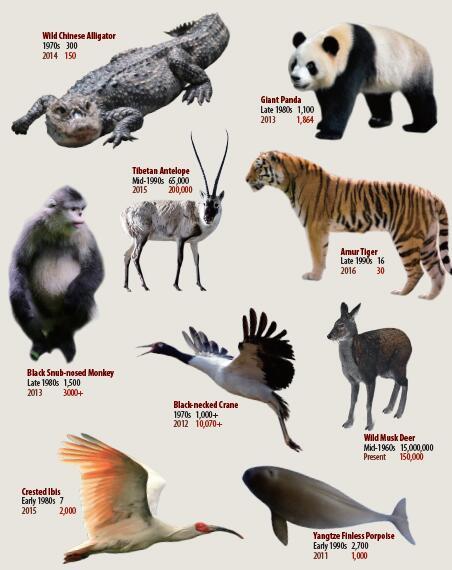
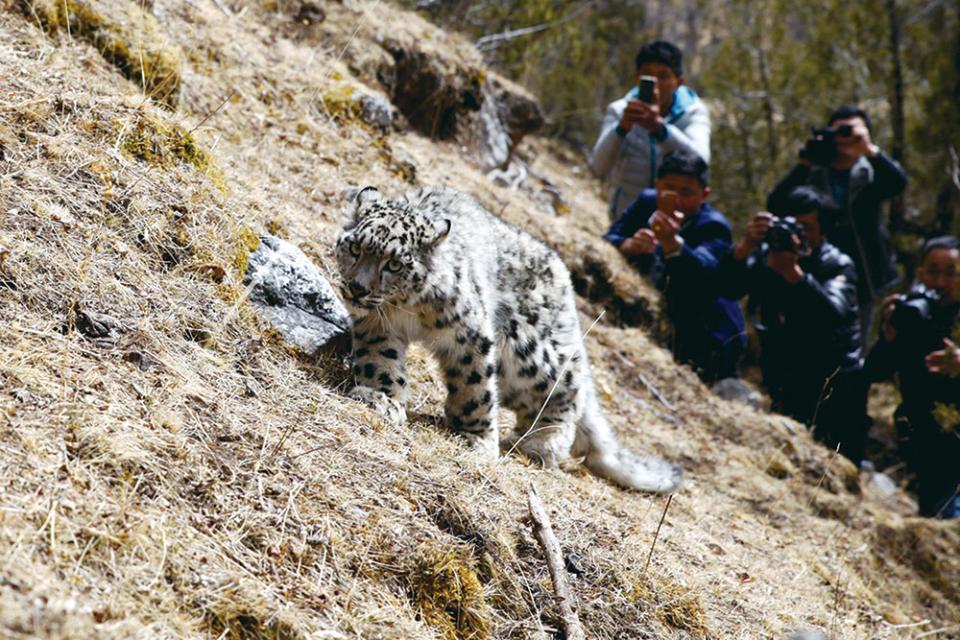
 Old Version
Old Version





